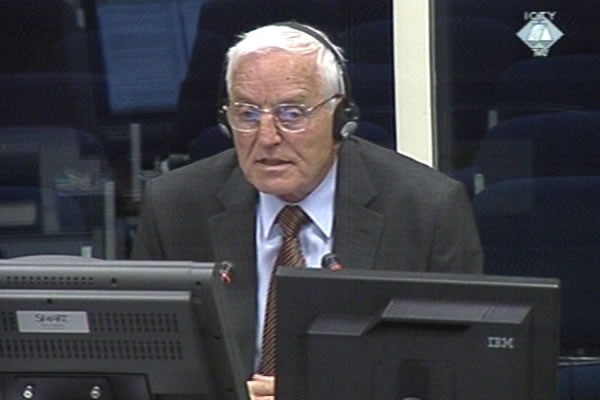Home
KARADZIC’S WITNESSES BLAME MLADIC’S ‘MILITARY CLIQUE’
Defense witnesses of the former Republika Srpska president tried to refute or at least call into question the Srebrenica massacre arguing that the accused didn’t know about the killings of Muslim men and boys. Finally, the defense witnesses shifted the blame – just in case – on General Mladic. According to the witnesses, Mladic was at the head of a ‘military clique’ that ‘worked independently’ using Karadzic as a ‘cover and screen’
 Dusan Kovacevic, defence witness of Radovan Karadzic
Dusan Kovacevic, defence witness of Radovan Karadzic In his statement to Radovan Karadzic’s legal team, former Republika Srpska defense minister Dusan Kovacevic said that the Bosnian Serb army never committed crimes. If any crimes did happen, it was the fault of ‘irresponsible individuals’ who failed to obey their orders. Kovacevic said that Muslims left the territory under the Serb control ‘voluntarily’. Serbs merely did them a favor by organizing transportation.
When he testified in Momcilo Perisic’s defense, Kovacevic said that he had learned about the events in Srebrenica in August 1995. Prosecutor Edgerton focused for the most part on this issue. Asked what exactly he had learned and who had told him, Kovacevic replied that in ‘informal conversations’ he learned from high-ranking VRS generals such as generals Mladic, Tolimir and Miletic, that a ‘small number’ of detainees had been ‘executed without control’. Kovacevic heard that they had been killed in revenge for the Serb casualties in the Podrinje area. The executions were ‘organized’ outside Srebrenica at several sites such as the farm in Pilica.
When General Kovacevic spoke about ‘a small number’ of executed victims, he said that he had learned from ‘an American Serb, Stefan Karganovic’ that 400 persons had been killed. Karganovic is a notorious denier of the crime in Srebrenica. Most of the Srebrenica Muslims had died in the clashes with the Serb army as they were trying to break out of the enclave, Kovacevic explained. Although he tried hard to play down the Srebrenica genocide, the witness did agree that the Tribunal had the requisite authority to establish ‘figures and facts’. In four judgments so far, the Tribunal has found that genocide was committed in Srebrenica and that thousands of Muslim civilians were killed there.
Kovacevic said that he did ‘not know or remember’ Karadzic ever mentioning the killings in Srebrenica. In the summer of 1995, the president was preoccupied with the problem how to defend the Republika Srpska borders on the Western front, Kovacevic said. Gordan Milinic, Karadzic’s security advisor, the man whose job it was to report all such occurrences to him, claimed today that no reports on the crimes in Srebrenica had reached the accused. Milinic is now a career diplomat; he had served as BH ambassador in Russia. In his statement to the defense, Milinic said that in July 1995 he regularly received intelligence reports from the army and the police. Since the reports didn’t mention the killing of citizens of Srebrenica, he basically didn’t have anything to report to Karadzic, Milinic claimed.
To further refute the existence of any links between the accused and the gravest single crime in the BH war, both witnesses spoke of the rivalry between Karadzic and Mladic. Things came to a head in the last year of the war, when the Srebrenica genocide happened. As Kovacevic recounted, Karadzic tried to dismiss Mladic but couldn’t do it because the officers in the Main Staff were against it. In his assessment of this contest, Milinic was much harsher: as the man ‘who knew all the secrets’ Milinic labeled Mladic’s Main Staff a ‘military clique’ that ‘worked independently’ using Karadzic as their ‘cover and screen’. Everybody saw that ‘something was amiss’, Milinic explained. According to Milinic, ‘no one would have died in BH if Karadzic had had his way’. Milinic also recalled the words of the accused that in the war in BH Serbs defended themselves ‘as a boxer does’, with ‘one hand tied behind his back’.
Directive 7 is the document that unequivocally shows Karadzic’s responsibility for the events in Srebrenica. Issued in March 1995, the document orders the troops to create conditions of ‘total insecurity with no hope of further survival or life for the inhabitants of Srebrenica and Zepa’ by ‘planned and well-thought-out combat operations’. The most vivid part of Milinic’s evidence focused on that point. Milinic claimed that Karadzic had been ‘deceived’, that he had mistakenly signed the document that contained military terms not typical of Karadzic. Prosecutor Pak asked Milinic if he really claimed that the supreme commander had signed a directive listing the ‘priorities, strategy and role’ of the armed forces without even bothering to read it. In yet another twist, Milinic now claimed that Karadzic didn’t even sign the document. The signature ‘only looked like’ Karadzic’s. Confronted with the fact that even Karadzic’s chef de cabinet had confirmed at the Tribunal that the accused had signed the Directive, Milinic replied that the signature ‘is similar but that I can’t guarantee it is the president’s signature’.
The cross-examination continues tomorrow.
Photos
Linked Reports
- Case : Karadzic
- 2013-06-10 FRENCH AND SERB NATIONALISTS DEFEND KARADZIC
- 2013-06-07 SESELJ’S THREATS STILL VALID
- 2013-06-07 EXECUTIONS ‘IN WAVES’
- 2013-06-12 AMBASSADOR DENIES GENOCIDE AND MOCKS VICTIMS
- 2013-06-13 WHEN DID ‘WHISPERS’ ABOUT CRIMES IN ZVORNIK REACH KARADZIC?
- 2013-06-19 KARADZIC’S WITNESS: ‘MORE THAN 50 PERCENT OF SREBRENICA IS FRAUD’

